Last Updated on June 7, 2023 by Georgie Smith
Unless you have a broody hen ready to sit, you’ll need an incubator to hatch fertilized eggs. While you can build your own, it’s convenient to purchase one that’s ready to use. After all, you’ll need to maintain the perfect temperature and humidity with a very small margin for error. The best chicken egg incubators can do that, plus turn the eggs, too.
Basic Comparison:
SSL
Storage
Domains
Sub-domains
Brinsea Products USAG47C
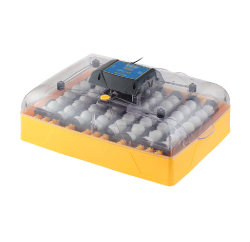
Humidity control
56 eggs
3-year warranty
22 x 15 x 9 inches
Farm-Innovators 4250
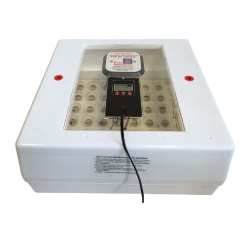
41 eggs
Easy to clean
120V, 40W, 0.33A
Easy to use
Brinsea-Mini Hatching
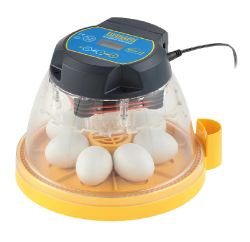
Fully automatic
18 W
Real perspective
Easy to use
An overview of how to incubate chicken eggs
Incubating eggs to get chicks isn’t difficult as long as you follow the guidelines. Most chicken eggs hatch within three weeks, or 21 days. It’s just a matter of keeping them at the right temperature and humidity and turning them over.
How soon after being laid should eggs be incubated?
You’re in luck if you can get your eggs from your own hens or a local supplier. If not, be sure to incubate them no more than 10 days after they are laid. It’s best if you can incubate sooner, within a week.
Before incubating, do fertilized eggs need any special treatment?
If you need to store the newly laid eggs for a couple of days, place them with their large end up. Keep them between 50 to 60 degrees with about 75% humidity. Shipped eggs need to rest for a day after their arrival, too.
If it’s a new incubator, how to set it up for first use?
Set up the incubator at least one day before you need to use it. Monitor the temperature and humidity to be sure the incubator works as it should.
The temperature dropped after the eggs were placed in it, now what?
You’ve warmed up the incubator at least one day in advance, so don’t worry. It’s good for the eggs to slowly warm up inside—the temperature should level off soon.
Is it reasonable to expect all the eggs to hatch?
Unfortunately, not every egg will hatch every time. It’s not unusual to only see half the eggs hatch. With good care and the best incubators, 80-100% may hatch for you.
What are the best temperature and humidity settings for an incubator?
Chicken eggs do best between 99 to 102 degrees during the whole period of incubation. Forced air-ventilated incubators often keep temps around 99 degrees. Still, air incubators usually hover around 102 degrees. Measure temperatures at the top of the eggs.
Humidity for the first 18 days should be around 50%. Then during the last three days, the humidity should be 65% to help with hatching. You can check humidity levels with a hygrometer, or you can gauge the eggs’ needs by candling. This may be a little difficult if you’ve never used candling to look at the air cells inside the eggs. Keep in mind that the relative humidity of the air where you’ve placed the incubator could affect it.
What about turning the eggs?
Take a pencil or nontoxic marker, crayon, or pen and mark an “X” on one side of the eggs and an “O” on the other. When you place the eggs inside the incubator, lay them down on their sides with either the X or O facing upward.
If you have an incubator that turns the eggs for you, you can check at a glance if it’s working properly. If you have to turn the eggs yourself, the markings make it easy to keep track. The eggs must be turned at least 3 times each day except during the last three days. In the last three days, they don’t need to be turned at all.
What to do to prepare for hatching?
The last time you turn the eggs is when you raise the humidity level to 65%. Place a clean cloth or paper towel underneath the eggs to catch the remains after hatching. You may need to take out the egg turner. Leave the incubator alone but keep watch.
Most of the chicks should hatch within 24 hours of each other. They will dry and their feathers will fluff up. They need to be kept at about 95 degrees for a day or two, and you can often keep them in the incubator for that. They won’t need food and water right when they hatch, even if they start to peck at each other’s feet or investigate their surroundings. But have water and mash ready as soon as you transfer them to their rearing box.
Where to learn more about hatching chicks, goslings, ducklings, and other birds?
There are many free resources online that cover how to incubate, hatch, and raise poultry. University websites with agricultural extensions are good places to look or even your local 4H club.
Now let’s take a look at the best chicken egg incubators.
The top incubators for chicken eggs
We’ll start off our reviews with a few from UK manufacturer Brinsea, a well-known incubation specialist.
Brinsea Mini Advance Hatching Egg Incubator
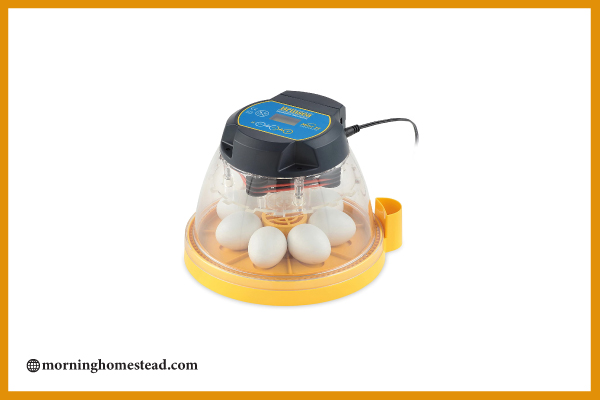
The Mini Advance Incubator from Brinsea is fully automated from day 1 to day 21. It fits 7 hen eggs, or you can purchase a different disk that holds up to 12 smaller eggs. The incubator maintains the proper temperature with a heater and fan, plus it turns the eggs for you. Two days before hatching, the egg turner halts.
The digital display reveals the temperature inside the incubator, but it doesn’t show the humidity level. The only way to control the humidity is to fill the reservoirs with water—one for the first 18 days, then both for the last three days.
Users say this method seems to work fine, and they have had success in hatching all their eggs. Other users say the incubator locks in humidity like a sauna, so owners in high-humidity environments might want to use less water, or monitor conditions with a separate hygrometer.
The microcontroller of the Mini Advance Incubator has an alarm for temperature alerts. Since the incubator can be used for other kinds of eggs besides hens, it’s possible to alter the temperature settings (like C or F, plus desired temperature) and the number of days to hatch. It also allows you to alter the turning interval and turning angle, and turn off the egg turner manually.
One very nice feature of this model is its transparent and clear polyurethane cabinet. It’s possible to see all the eggs inside. This plastic is antimicrobial and resistant to UV radiation, chemicals, oils, and abrasion.
While it’s operating, the incubator only needs 12V of electricity and consumes 18W. It’s lightweight at 2.1 pounds and compact at 6.5 by 8 inches. If you choose to place a standalone hygrometer inside, it will take up one hen egg’s worth of space, but may give you peace of mind.
While the Mini Advance has been a popular product for some time, it’s been retired by Brinsea and replaced by a new model, the Mini II Advance.
Brinsea Mini Advance Incubator Small Egg Tray
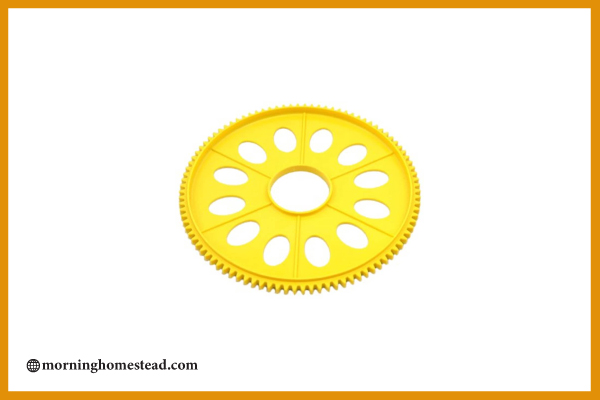
This is the small egg tray that fits inside the Brinsea Mini Advance incubator. It holds quail and pheasant eggs.
Brinsea Products Mini II Advance Automatic 7 Egg Incubator
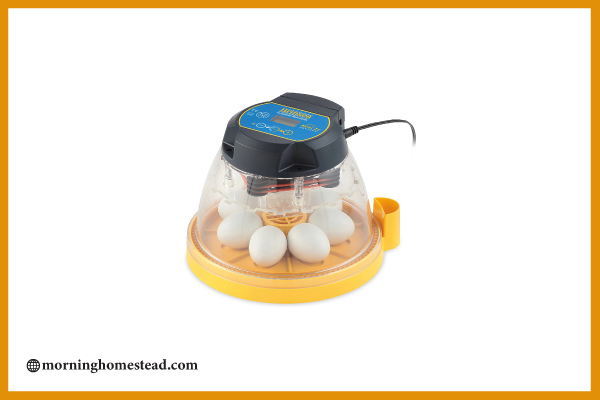
Brinsea’s Mini II Advance Automatic Incubator is the company’s new and improved replacement for the Mini Advance. It holds up to 7 hen eggs (or 14 quail eggs with the other disk, sold separately).
If you compare it to the Mini Advance (reviewed above), there are a few differences. One is that there is an external opening for topping off the water reservoirs. This keeps the temperature inside constant since there is little to no need for opening the incubator.
Another difference is besides the internal temperature alerts, there is a room temperature alarm. But there still isn’t any way to control or determine humidity levels inside the incubator without an additional hygrometer.
Like the previous model, the Mini Advance II is very easy to use. The display shows the temperature in C or F, the number of days until hatch, and the turning status. You can use the microcontroller to adjust the turning rate and angle, the temperature, and the number of days to hatch. You can also set alarms for high and low-temperature alerts. Then, two days prior to the hatch, the automatic turner halts in preparation for the chicks to emerge.
The clear ABS plastic of the incubator cabinet makes it very easy to see all the eggs. The plastic is easy to clean, resistant to scratching, and anti-microbial. Brinsea offers a 3-year warranty on the whole product.
If you would like an incubator that allows you to monitor humidity, take a look at the Brinsea Mini Advance EX below.
Brinsea Products Fully Automatic Egg Incubator
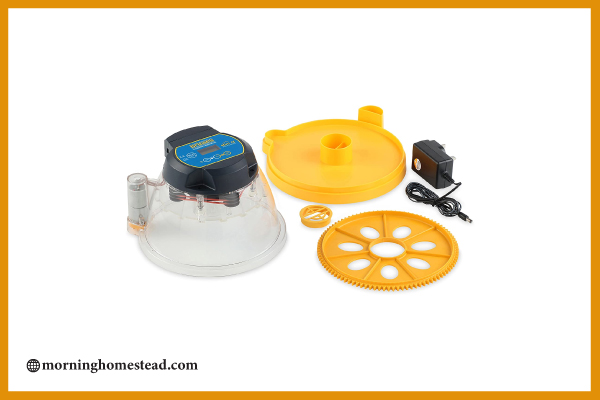
While users with the Mini Advance and Mini Advance II seem to hatch well enough without a humidity controller, the Mini Advance EX gives peace of mind to breeders of valuable eggs. It has all the easy-to-use features of the other incubators plus an external humidity pump and automatic humidity control.
The microcontroller and digital display make it possible to set %RH, program the ideal temperature range, and the turning rate and angle. The turning rate can be set to suit parrot eggs as well as hen eggs. And the Mini Advance EX comes with both a hen-size egg disk and a pheasant or quail-size egg disk.
Brinsea Products USAG47C Ovation 56 EX fully automatic egg incubator with humidity control
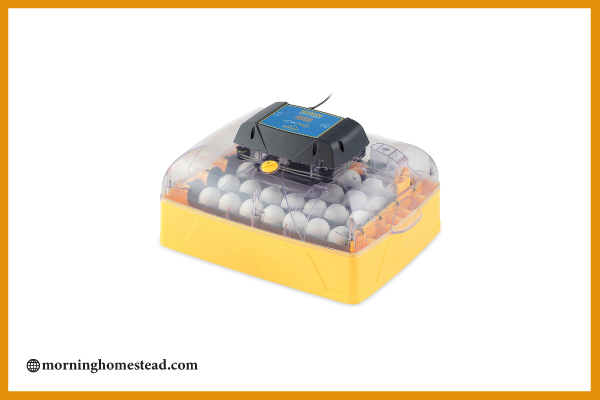
If you want to hatch up to 56 eggs at once in a professional-grade machine, try the Brinsea Ovation 56 EX. It has automatic temperature and humidity controls plus automatic turning. Like the other Brinsea incubators, this one makes it easy to view your eggs and maintain sanitary conditions. It’s built of ABS plastic that resists bacteria and microbes and is easy to clean.
The display shows the status while the microprocessor lets you program the desired ranges of temperature and humidity, plus alarms, and egg-turning intervals. Those features make it possible to hatch not just hen eggs, but other kinds as well. You can purchase parts to suit smaller eggs. The Ovation 56 EX is covered by a 3-year warranty.
Brinsea BGB Ova Easy 190 Advance Cabinet Incubator

If you have up to 190 hen eggs to incubate, you may appreciate the Ova Easy Advance Cabinet Incubator. It has an integral hatcher for 48 eggs at a time.
The digital control system manages temperature, humidity, and turning options. It has alarms for interior and external temperatures, and it can display in Celsius or Fahrenheit. The double-glazed glass door makes it easy to see inside.
GQF 1588 Genesis Hova-Bator Incubator
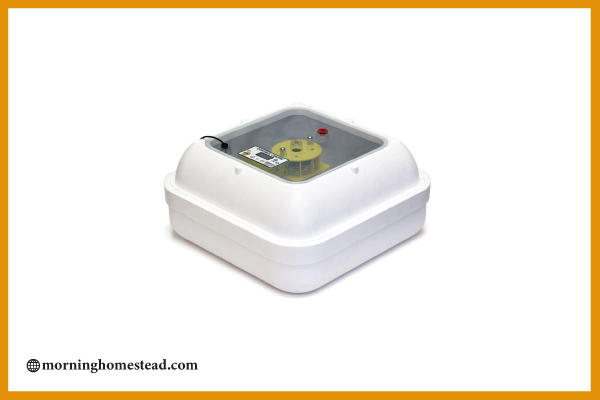
GQF is another recognized name in incubation products. Their 1588 Genesis Hova-Bator is a mix of high-tech and sensible construction to keep costs down. While the body is made of heat-conserving (and inexpensive) Styrofoam, the microprocessor inside keeps the temperature exactly as it should be.
1588 can hold up to 50 hen eggs at a time and keep their environment at a cozy 99.9 F. There is a reservoir underneath that needs to be filled to maintain the proper humidity levels. While you can view the eggs through the transparent plastic top, you can’t view the water level that way. But you can view the humidity level and temperature on the LCD display embedded in the lid.
This incubator does not come with an egg-turner, but you can purchase one separately or get the Deluxe Combo Kit below. The 1588 incubating unit measures 18.5 by 18.5 by 9.5 inches in size. It’s TUV-listed for electrical safety.
While the HovaBator Genesis 1588 is a top seller, it may not be ideal for hobbyists who are raising only a handful of chicks at a time, or for serious breeders who need a more durable unit.
HovaBator Genesis 1588 Deluxe Egg Incubator Combo Kit
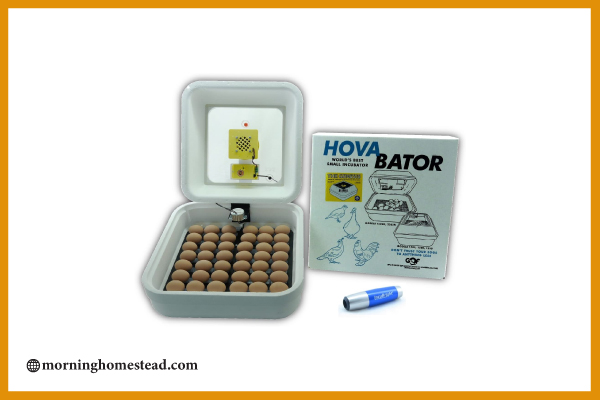
The GQF HovaBator Genesis 1855 Deluxe Combo Kit includes the incubator reviewed above plus an automatic egg turner and an egg candler. The IncuTurn egg turner imitates nature by rolling eggs gently 6 times per day to turn them. Two days before hatch time, simply remove the egg turner in preparation for the chicks’ arrival.
The IncuBright Egg Candler has 6 cool-to-the-touch LED lights to provide a clear view inside your eggs. The edge of the light is covered in soft rubber to protect the eggs from damage and to create a better light seal.
GQF Digital Sportsman Cabinet Incubator 1502
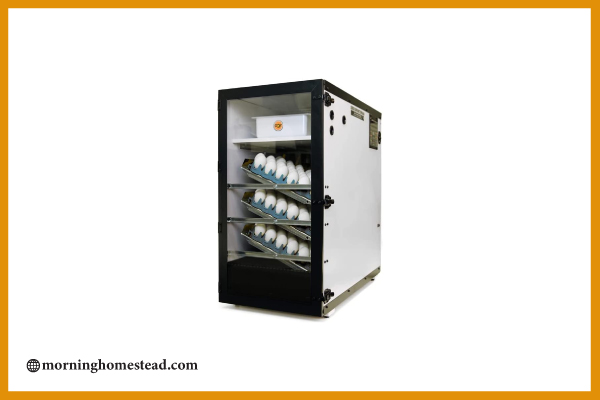
Farmers don’t have time to hatch small batches—they need a big incubator, preferably with a hatching function. The GQF Digital Sportsman can handle up to 270 chicken eggs at a time and has a hatching tray at the bottom.
This incubator has a computer that monitors the environment once a second and shows the current conditions on the LCD display. Both the temperature and humidity is automatically controlled.
The incubator turns the eggs automatically in the top three racks. You can set a new rack to incubate each week, then move the 18-day-old eggs to the bottom rack for hatching while the newer eggs keep incubating.
IncuView All-In-One Automatic Egg Incubator with built-in Automatic Egg Turner
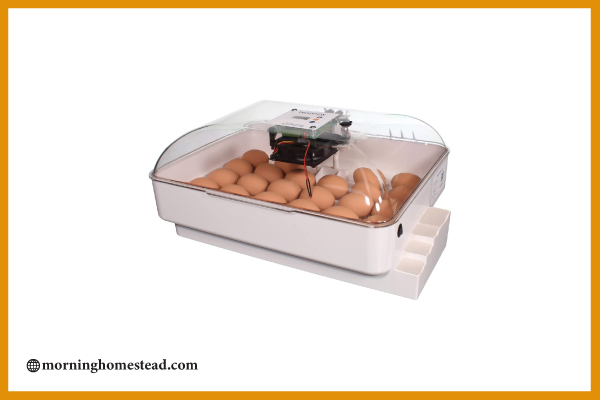
The IncuView from Incubator Warehouse is a tabletop model designed to hold up to 27 hen eggs at a time. It comes with an automatic egg turner, a humidity gauge, and automatic temperature control that displays in both C and F.
It’s a bit more durable than the HovaBator because it’s built with plastic, not Styrofoam. The 40W heater is controlled by a thermostat to keep the temperature steady. It comes preset at 99.5 F but can be adjusted to suit other kinds of eggs. Instead of turning on and off, the heater receives more or less power to put out more or less heat, according to need.
The built-in hygrometer and humidity rings make it easier to control humidity than on some other brands of incubators. The display shows the current %RH as well as the recommended range for that stage of the incubation process. You can fill one, two, or all three rings with water depending on your own environment’s relative humidity and what the eggs require.
The egg turner works automatically to gently roll the eggs 6 times per day (or as many times as you set it to do). You can watch the process through the large clear plastic window lid. Simply shut down the egg turner two days before hatches.
Farm Innovators Model 4250 Digital Circulated Air Incubator with Automatic Egg Turner
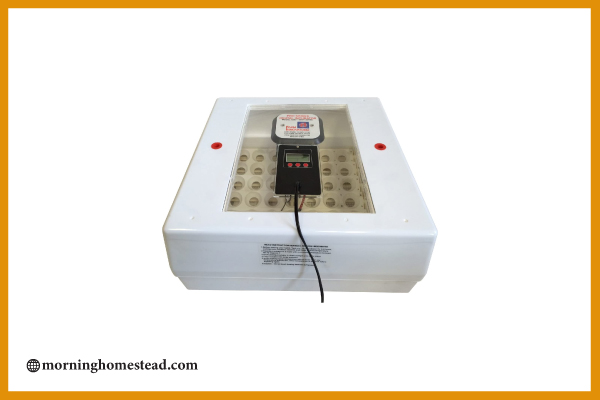
The Farm Innovators Model 4250 is another model built with a Styrofoam body. It maintains the temperature inside with a heater and fan that pulls air in from outside the incubator. You can keep an eye on things with the large clear window in the lid and the digital display.
If the temperature goes below 97 F or above 103 F, a warning light flashes. The automatic egg turner can handle up to 41 eggs at a time and turns them once every 4 hours. Although some users report success, this would not be an ideal incubator for a serious breeder.
Magicfly Digital Mini Fully Automatic Egg Incubator
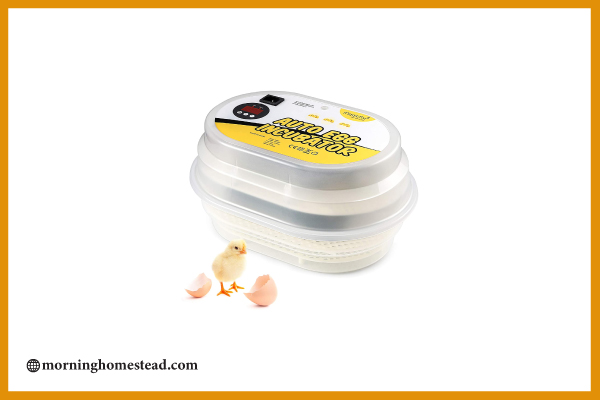
Companies like Brinsea consider products like the Magicfly Egg Incubator to be unsafe knock-off products. (You can actually see which ones they list if you visit the Brinsea website.) But the Magicfly incubator has achieved both CE and C-tick certifications and it complies with ROHS standards.
What does that all mean? CE means that the device is safe enough to be sold in the European Union. C-tick means it complies with electromagnetic interference rules in Australia. ROHS means its components do not contain hazardous components like lead. None of this is the same as UL-listed, for example, but it’s a start.
We saw two main complaints about this particular incubator. One is that it’s made of transparent but not clear plastic. The view of the eggs is quite hazy. And two, it comes with instructions that are very difficult to decipher.
The incubator holds up to 8 to 12 eggs and has an automatic egg turner and automatic temperature control. The rails of the turner are adjustable to accommodate various egg sizes. The plastic bottom of the incubator lifts out and reveals a shallow reservoir that can hold water to provide humidity. You’ll need to check that each day.
Feedback on this incubator is generally positive, but it seems designed for children, hobbyists, or first-time breeders who are curious. Serious breeders may desire a different model.
Important features to consider in an incubator
We’ve reviewed several incubators today, from small tabletop models for home use, to medium-sized ones for class use, and large cabinets for farmers and breeders. If this is your first time purchasing an incubator, consider the following features.
Size of the incubator
While you might be experimenting now with a handful of eggs, are you thinking about hatching more chicks in the future? Will you be raising them to keep at home, or will you sell them?
The durability of the incubator
While you can definitely save money now with a Styrofoam incubator, be aware that they tend to crack with repeated use. They are also harder to clean than plastic ones.
Safety of the incubator for you and your chicks
As Brinsea points out on their site, not all incubators are created equal. Some are certified for electrical safety. That’s important because this is a device that will be running non-stop for three weeks.
Features included with the incubator
The first time you hatch eggs, you may be fine with the commitment to turning them every few hours. But after you’ve finished that first round of 21 days, you may prefer to have an automatic egg turner.
The same goes for humidity controls. If you live in an arid or very humid environment, you can benefit from an incubator that keeps the eggs at a comfortable 50% RH. Pay attention to how you need to fill the water reservoir—will you have to open the lid and expose the eggs to changes in temperature, or is there an externally-accessible place to fill it?
Finally, while you might save money by selecting an incubator with a small viewport or none at all, it’s much nicer to be able to see all of your eggs while they incubate.
Accessories for incubating and hatching eggs
If you want to check the progress of the embryos, some have had success with this LED candling light.
Magicfly Bright Cool LED Light Egg Candler Tester
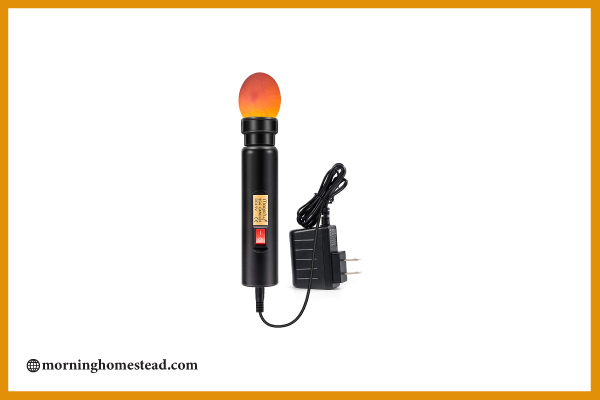
Magicfly’s Bright Cool LED Egg Candler has soft rubber adapters to protect the eggs while you look at the embryos inside. The adapters form a light seal so that the maximum amount of light enters the egg. The light from the candler comes from LED bulbs that are cool to the touch and non-threatening to the eggs. The light requires electricity to operate but comes with a long power cord.
IncuTherm™ Digital Thermometer Hygrometer
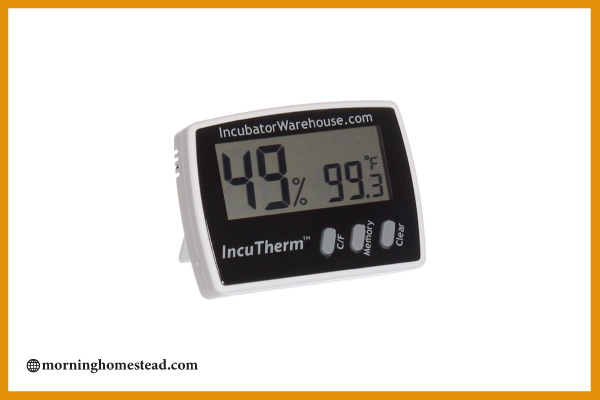
If you need to measure temperature and humidity, this IncuTherm Digital Thermometer and Hygrometer is a popular product with an easy-to-read display. It keeps track of highs and lows so you can check the history of how your new incubator did during the night. It comes with a battery so it’s ready to use, and it’s covered by a 1-year guarantee.
Hatching & Brooding Your Own Chicks: Chickens, Turkeys, Ducks, Geese, Guinea Fowl by Gail Damerow
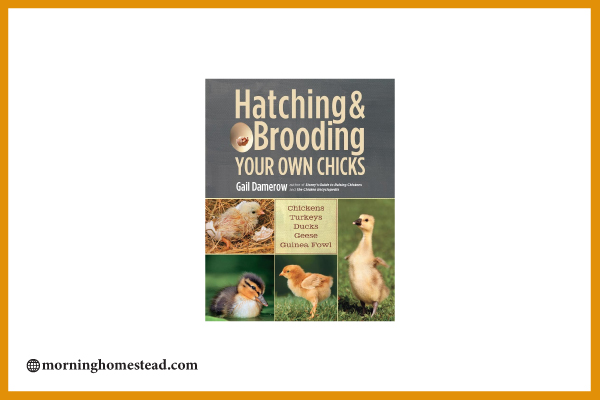
If you’re new to raising chickens or other fowl, this is the book you want to turn to for advice. She covers selecting breeds, incubating, hatching, and brooding. The book gives good detailed information on embryo development and more, without being overwhelming. Get it in paperback or Kindle formats.
Brinsea EcoGlow Brooder for Chicks or Ducklings
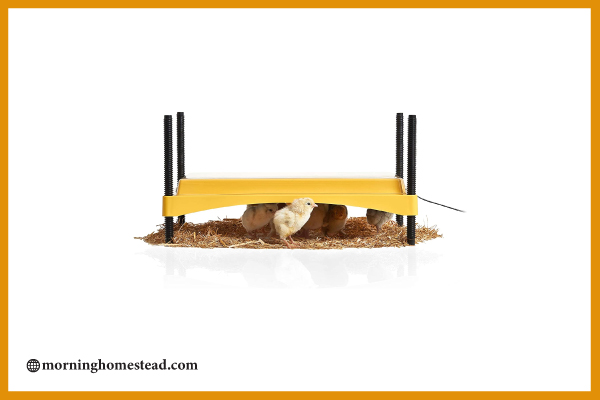
Once your chicks hatch and you’re ready to move them from the incubator, they need a warm environment. The EcoGlow Brooder from Brinsea is durable and light on your electric bill. It has three temperature settings (based on three different heights) to keep chicks happy and healthy.
The brooder provides radiant heat in a safe way. Chicks can brush up against it, or shelter under it. It can be placed in a number of different ways to suit your home for them and their needs. The power cord is ten feet long so you can place the brooder where you need it to be without worrying about extension cables.
The surface is resistant to damage, anti-microbial, and easy to clean. Since it only consumes 18W of electricity, it doesn’t cost nearly as much to run as traditional heat lamps.
Conclusion
We hoped you discovered the best incubator to hatch your chicken eggs. Now that you’re going to have chicks to raise, take a look at our reviews of the top chicken feeders and waterers. Come visit us soon for new reviews of the best products for your home, garden, and animals.



![Best Brooder For Chicks Or Ducklings: Reviews And Guide [2023] Best-Brooder-Reviews](https://morninghomestead.com/wp-content/uploads/2022/07/Best-Brooder-Reviews-150x150.jpg)

